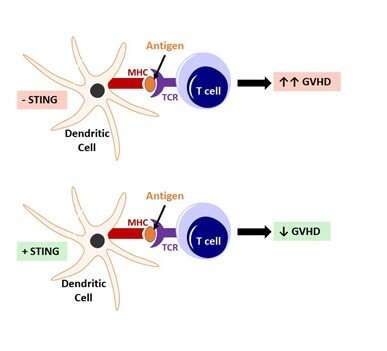
MUSC Hollings Cancer Center researcher Yongxia Wu, Ph.D., identified a new target molecule in the fight against graft-versus-host disease (GVHD). Bone marrow transplant, a treatment for certain blood cancers, is accompanied by potentially life-threatening GVHD in nearly 50% of patients. A January 2021 paper published in Cellular and Molecular Immunology revealed that activating a molecule called STING may be a new approach to reduce GVHD.
Xue-Zhong Yu, M.D., professor in the Department of Microbiology and Immunology, focuses on understanding the intricate immune mechanisms that regulate GVHD development and anti-tumor activity.
Recently, STING (stimulator of interferon genes) has been highly studied in the context of cancer. Data from other groups has shown that STING activation in T cells helps the immune cells fight cancer. Cancer cells are essentially a “bad” version of the body’s own cells and an appropriate target for its immune system. In contrast, in the case of GVHD, T cells fight the body’s own “good” cells—in essence, the body attacks itself. Based on the previous data, it seemed logical that high STING activation, though good when it comes to cancer, would be bad in the context of GVHD. Yu’s findings in a mouse model of GVHD confirmed this hypothesis. In the mouse model, which was obtained from collaborator Chih-Chi Andrew Hu, Ph.D., a Wistar Institute professor of Pathology and Laboratory Medicine, GVHD was induced by bone marrow transplant, which closely models the disease development in humans.
To understand how GVHD develops after bone marrow transplantation, one must consider two immune systems: the donor’s and the recipient’s. The key immune cells are the antigen-presenting cells and the T cells. The immune system knows what to attack based on specific “tags,” called antigens, that are shown to the T cells by the specialized antigen-presenting cells. Dendritic cells are the most effective antigen-presenting cells, and they play a critical role in GVHD.
Work from other research groups in cancer has demonstrated that STING signaling can regulate antigen- presenting cell function. STING is an important molecule in a DNA-sensing pathway that results in the production of inflammatory cytokines. But it is not known how STING regulates these cells in the context of GVHD.
The researchers used the mouse models to determine whether GVHD improved or worsened when STING was 1) absent in the donor immune cells, 2) absent in the recipient immune cells and 3) overexpressed in the recipient immune cells. GVHD severity was not changed when STING was absent from the donor immune cells. However, GVHD was more severe and mortality rates were higher when STING was missing from the recipient immune cells.
Yu and collaborators then looked at different cell subsets to try and understand which cells were most impacted by the loss of STING. Surprisingly, STING expression in the recipient mouse’s antigen-presenting cells (dendritic cells) reduced donor T cell expansion and migratory ability after bone marrow transplant. In other words, it made it less likely that the T cells of the recipient mouse would attack its “good” cells and lead to GVHD. This finding was confirmed using a pharmacological drug that turned on the STING molecule. Activating STING in the host before transplantation reduced GVHD severity.
The finding in a mouse model that activating STING with a pharmacological drug reduced GVHD could be clinically relevant in that it suggests the possibility that a STING-activating drug might protect bone marrow transplant recipients from GVHD. Much more basic and clinical research will be required to assess that possibility, but Yu’s findings suggest that such research is warranted.
To understand why the research team observed what they did, they will continue to unravel the biological functions of the STING molecule. Unanswered questions include what makes STING function differently in different immune cell subsets.
Source: Read Full Article